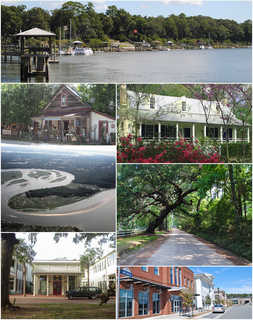
The Sea Islands are a chain of tidal and barrier islands on the Atlantic Ocean coast of the Southeastern United States. Numbering over 100, they are located between the mouths of the Santee and St. Johns Rivers along the coast of the US states of South Carolina, Georgia, and Florida.
Newtown is a part of the Municipality of New-Wes-Valley, located at the North end of Bonavista Bay in the province of Newfoundland and Labrador, Canada. The approximate population is 400. Settlement in Newtown originated around 1850 when people relocated from nearby areas. Newtown is well known for being built on many small islands, and is the home of the Barbour Living Heritage Village.

Pre Rup is a Hindu temple at Angkor, Cambodia, built as the state temple of Khmer king Rajendravarman and dedicated in 961 or early 962. It is a temple mountain of combined brick, laterite and sandstone construction.
Pritchardville is an unincorporated community in Beaufort County, South Carolina, United States, located between Hardeeville and Bluffton on South Carolina Highway 46. The community takes its name from nearby Pritchard Farms.
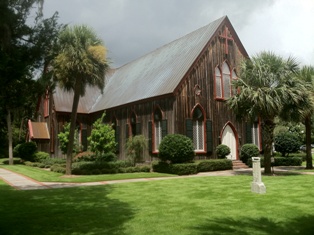
The Church of the Cross is a historic Episcopal Church on Calhoun Street in Bluffton, South Carolina.

The Court Street Commercial Historic District is a largely intact part of the old downtown of Richland Center, Wisconsin. It was added to the National Register of Historic Places in 1989 - a 11.2 acres (4.5 ha) historic district which included 51 contributing buildings and 20 non-contributing ones. The buildings are commercial, mostly in Late Victorian styles constructed from 1870 to 1938. Most are brick two-story buildings; a few one-story and three-story brick buildings are interspersed.
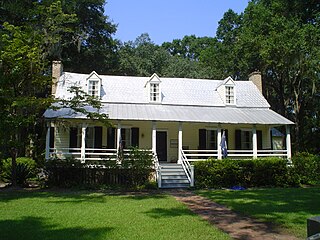
The Heyward House, is located in Bluffton, South Carolina. It was built in 1841 in the early Carolina Farmhouse style brought to North America by planters from the West Indies. The north parlor and the bedroom above, were the first parts of the house built by John J. Cole and his slaves in the early 1840s as a summer home for his wife Carolina Corle and their children. John J. Cole was a planter who owned Moreland Plantation located on present day Palmetto Bluff. By 1860, Cole had more than doubled the size of the house and his family, at which time the front and side windows in the front rooms were replaced with larger windows. The original parlor windows were reused in the dining room and back bedroom. The interior is clad with wide heart pine boards.
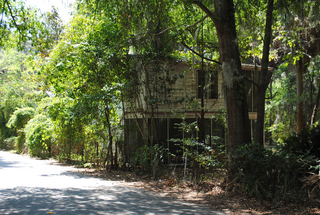
The Squire Pope Carriage House, is located in Bluffton, South Carolina. It was built in 1850 and joined in 1865. The house originally served as the carriage house and outbuildings for the summer house of Squire William Pope, this two-story frame structure, circa 1850 is located at the back of a deep lot overlooking the May River. Pope was a wealthy landowner from Hilton Head Island who owned the Coggins Point Plantation. He served in the South Carolina Senate and represented St. Luke's Parrish in the SC House of Representatives. The main house was burned the day of the Burning of Bluffton. When the family returned following the Civil War, they joined these buildings together to serve as their home. The structure is one room deep with porches across the May River facade.
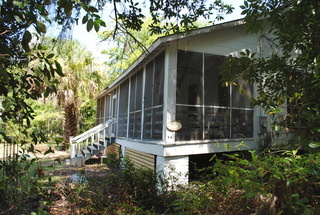
The Allen-Lockwood House is located in Bluffton, South Carolina. It was built in 1850. This cottage was built by William Gaston Allen on the northwest corner of Calhoun and Water Streets for his wife Susan Virginia Bolan and their six children. It is a classic example of the Lowcountry summer cottage with its gabled roof, high-ceiling rooms and numerous windows for cross-ventilation. Raised on brick piers, a wide porch spans the south facade.
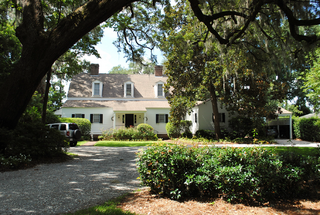
The Huger-Gordon House, is located in Bluffton, South Carolina. It was built in 1795. This is the only antebellum house located on the bluff overlooking the May River that survived the Burning of Bluffton on June 4, 1863. Minié balls, lodged in the front door studs give evidence of the sniping that took place between Union forces and Confederate pickets here. The frame 1 1⁄2-story building is placed on a low brick foundation of piers with a gabled roof and interior chimneys. A one-story veranda with a shed roof and chamfered posts, runs the width of the house on the riverside and the central dormer has glass doors cut into the eave of the roof and veranda. It is believed the house was built around 1795 and enlarged in the 1820s. The owner in 1863 was Colonel Ephraim Mikell Seabrook who had acquired the property from Dr. William Lowndes Hamilton in 1855. Dr. Joseph Alston Huger, II bought the property from the Seabrook's in 1882 and it has remained in the Huger family. Mr. & Mrs. Hugh Gordon made alterations to the exterior and interior in the 1970s.
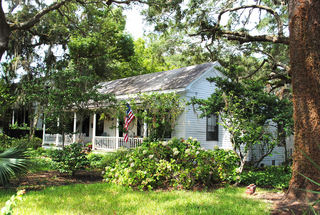
The Fripp-Lowden House is located in Bluffton, South Carolina. It was built in 1909. This Lowcountry cottage was built in 1909 for Alfred Fripp and his wife Sallie Williams. It is a one-story frame building of pine with a porch across the facade. It is surrounded by a garden that started by Mrs. Fripp, who raised camellias. "The Sallie Fripp" can be seen here when in bloom and is now in many Bluffton gardens. The Fripps' daughter, Mrs. H. O. Lowden, Jr., continued to expand the garden. Today, Lynn Hicks is the current owner of The Fripp-Lowden House, and major renovations are currently being completed to preserve this beautiful historic property. In addition, the building houses the studio of the noted local artist and art professor Amiri Farris.
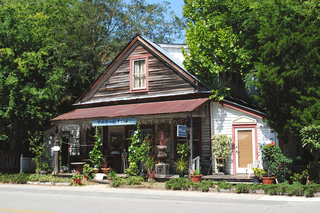
The Store, is located in Bluffton, South Carolina. It was built in 1904. The Store sits on a large tract of land which is thought to have been the property of Mrs. John Hais Hardee, née Harriet Saussy. She was listed as the "Head of Household" and a "Planter" in both the 1850 and 1860 Census. There are no known records of who owned the property from 1865 to 1900 when it was owned briefly by the Trustees of the School District #2. In 1904, Jesse Davidore Peeples of Scotia, SC bought the property and built a store and a home beside it for his family. He had five children by his first wife, Willie Mae Stokes and ten by his second wife, Maud Estella Guilford. The house contained six bedrooms and a large sleeping porch.

The Carson Cottage, is located in Bluffton, South Carolina. It was built in 1890. The first owner of this cottage, J.J. Carson distinguished himself at the Battle of Chancellorsville, May 2-4, 1863, by braving the gunfire of the battleground and rescuing the mortally wounded General Stonewall Jackson. Placing Jackson's body in a buckboard, Carson drove back through enemy lines to the Confederate's side. After the Civil War, he returned to Bluffton and built the cottage about 1890. In 1900, he organized the First Baptist Church of Bluffton and services were held in the house until a church building was completed. This one-story house on short piers has a charming front porch. The structure was recently moved forward and renovated.
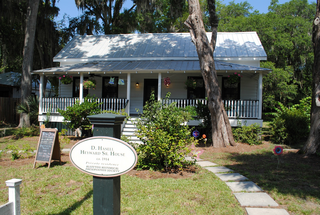
The D. Hasell Heyward House, is located in Bluffton, South Carolina. It was built in 1914. This cottage was built by Nathan Crosby in 1914 for Daniel Hasell Heyward, Sr. and his wife Hattie Mae Mulligan. Constructed of pine on high brick pilings it has a wide central hallway flanked by large high-ceiling rooms with horizontal narrow pine boards on the walls and ceilings, simple moldings and tall windows front and back. A wide porch stretches the length of the front facade. The structure was restored by Lewis Hammett, Jr. Esq. and serves as his law offices.
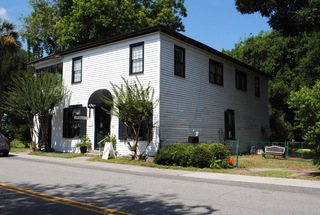
The Planters Mercantile, is located in Bluffton, South Carolina. It was built in 1890. Unlike most 19th century commercial buildings on Calhoun St., the Mercantile is built with two full stories; the ground floor store has very high ceilings, tall windows and entry doors. The store was a business which offered the area, according to their bill head: Clothing, Dry Goods, Boots, Shoes, Hats and Groceries, Furniture, Wagons, Buggies, and Harness, Sewing Machines, Trunks and Satchels, Cigars, Feed, Grits, Flour, Boat Supplies, Coffins and Fixture. Abram suffered an early and possibly accidental death. In 1920 Moses sold the entire property to Julius Ulman and J. Weitz; then in 1930 Paul J. Viens bought it. It then passed back and forth between the Viens and Pinckneys, during which time a Mr. Goodman operated a store there. After his death, Morris Robinowich kept store there until 1972. Many individuals and groups have operated shops and stores therein.

The Cordray House, is located in Bluffton, South Carolina. It was built in 1910. In the 1860 Census for St. Luke's Parish, one Isaac H. Martin, mason and a free black man, his wife Pauline H. Martin and their children, Philip, Mary E., Isiah and John H were listed. In the Charleston Mercury account of the 1863 Burning of Bluffton, it is stated that the federal troops set fire to the Martin House. The 1913 Plat Map of the Town of Bluffton shows the Martin property had been divided into several lots, including the site of the present Cordray House. Several families have owned parts of this property. The last remaining Praise House in the Historic District is behind the Cordray House.

The Villa, Casa Casuarina, also known as the Versace Mansion, is an American property built in 1930, renowned for being owned by Italian fashion impresario Gianni Versace from 1992 until his death, located on Ocean Drive in the Miami Beach Architectural District, Florida. Since 2015, it has operated as a luxury hotel known as The Villa, Casa Casuarina.
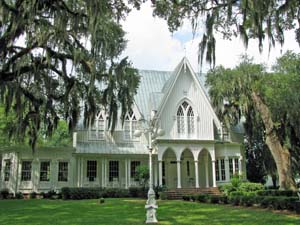
Rose Hill Mansion is an historic site in Bluffton, Beaufort County, South Carolina, that preserves the antebellum plantation home of Dr. & Mrs. John William (1803-1868) & Caroline (1815-1864) Kirk, a wealthy planter and physician. The original Rose Hill Plantation property of 1880 acres was a wedding gift from James Brown Kirk to his eldest daughter, Caroline in 1838. Construction on the plantation house was begun in 1858. The land was used to grow cotton, rice and indigo during these years. Rice and cotton were the primary cash crops and salt was harvested from the nearby brackish creeks.
The Brigham City Co-op was one of the most successful cooperative enterprises of the Mormons in Utah.

